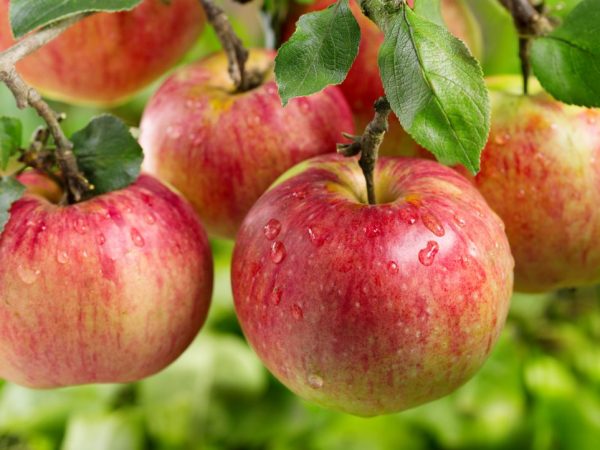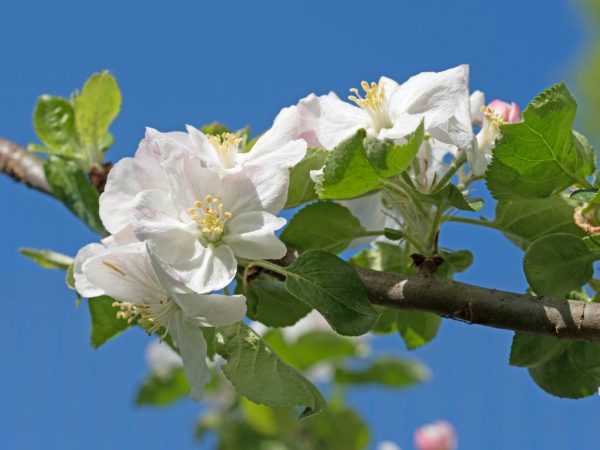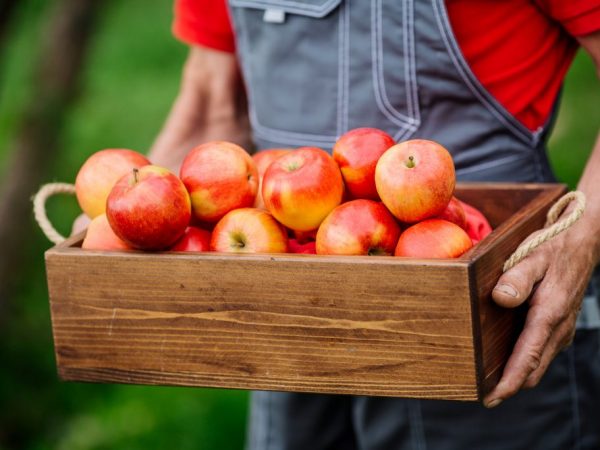Features of growing apple trees Auxis
Apple tree Auxis is a fairly common variety, the fruits of which have a rich taste and pleasant aroma. They are often used in the preparation of dietary meals, because in their composition they contain substances (fiber and organic compounds) that can burn fat cells in the body.

Features of growing apple trees Auxis
Description
According to the information provided by the Lithuanian breeders who bred this variety, the apple tree of this species is a whimsical tree that requires maximum care and supervision. The hybrid turned out as a result of crossing Macintosh and red Grafenstein apples.
Characteristics of the tree
The apple tree can grow up to 6 m in height, but, according to the description, its growth ranges from 3.5 to 4 m. The deciduous cover has a round shape and an average density of overgrowth. The appearance of the first ovaries, indicated by flowering, is observed in late spring.
The crop is prone to cross-pollination with different types of trees that coincide with it in flowering period.
Description of the fetus
One apple can grow from 100 to 150 g. Sometimes you come across fruits that reach 170 g. Apples have a round shape, slightly flattened at the edges. They are covered with a waxy coating and have a dense skin of medium thickness.
The fruit is yellow with red blotches. The pulp is quite firm and has a natural yellowish color. In terms of taste, the fruits have a good ratio of sweetness and sourness.
Dignity
The Auxis apple variety stands out for its characteristics. Among the positive are the following:
- high resistance to low temperature environment;
- high yield at the end of the ripening period;
- early terms of fruiting.
Among the shortcomings of the variety, only rapid shedding as a result of overripe can be distinguished. Because of this, apples can get mechanical damage. In this case, the decay process will begin.
Landing
It is carried out in early spring, when the first ovaries have not yet appeared on the trees. You can plant a tree in an even warm ground in early autumn, so that before the first appearance of frost it is about two months.
The place for this needs to be prepared in the fall, and if the planting will take place during this period, then at least a month before the start of work.
The hole must be of a certain size so that the root system of the tree has enough space for growth: a circle of about 1 m in diameter and up to 80 cm in depth. The planting mass should contain mineral fertilizers and organic matter.
If there are no impurities, it is recommended to add ash, humus and superphosphate. After planting, pour water over the hole; an earthen trench can be made around it in order to retain a sufficient amount of moisture.
A correct planting scheme has been developed, thanks to which trees will form correctly. It is recommended to sow them at a distance of up to 4 m in a row and 6 m between them.
Care

Fruit trees are watered three times a year
To harvest a high harvest of apples at the end of September, the following agricultural rules must be followed.
Watering
Watering is carried out at the rate of 1 bucket of water for each year of the formation of a young apple tree. If the season is dry, the volume of liquid increases. After the tree has begun to bear fruit, you need to water it 3 times a year: at the beginning of summer, during the ripening period and at the end of autumn.
Top dressing
In the first year of planting, you can do without the introduction of additional fertilizers. During this time, it is recommended to periodically loosen the soil so that the roots receive a sufficient amount of oxygen.
After that, fertilizers are applied: in the fall - compost and potassium, in the spring - nitrogen, which is added 2 times a year - most of it in early spring before the buds bloom, and the rest - after the end of the flowering period.
In the first years of tree growth, top dressing is applied to a depth of 20 cm, and then - up to 45 cm. If the apple tree grows in cool areas, it is recommended to mulch it for the winter. The raw material for this process can be dry foliage, humus or coniferous needles.
Pruning
Pruning is essential to rejuvenate the tree. Correct crown formation can ensure the appearance of new ovaries, and, accordingly, an increase in yield. At the beginning of spring, old dried branches are removed so that they do not interfere with the growth of new formations.
Correct pruning can also affect crop protection against pests. In autumn, the lower part of the trees is whitewashed in order to protect against small rodents.
Reproduction
The variety is propagated by root cuttings or layering.
Cuttings can then be used as grafts. It is better to prepare them in the spring, when the tree has not yet begun to produce sap. Cuttings are cut approximately 20 cm each and placed in a container with sand. Then they put it in a cool, dark place.
Division by layering is carried out in the spring. The lower thin branches of the tree are lowered and tied to the trunk with a wire. After that, the branches that have touched the ground are sprinkled with soil and spud. During the summer period, they gain strength, and at the end of the season they can be excommunicated.
Any apple trees that begin to bloom at the same time as Auxis can be used as pollinating varieties, because this species is not capable of self-pollination.
Ripening and fruiting
The Auxis apple variety begins to bear fruit depending on the rootstock on which it is grown. If development came from seeds, then the first harvest can be expected at about the 5th year of growth. If the tree has grown from a seedling, fruits may appear as early as the 3rd year of development.
The variety can bear fruit every year with an average yield. An exception may be the seasons, when climatic conditions uncharacteristic for it are observed in the territory in which the apple tree grows.
The period of abundant flowering is pronounced in late spring, when white-pink buds appear on the branches, and a sweet aroma is in the air. After the fruits ripen, they can be harvested at the end of September.
You should be careful during this period so as not to miss the time when the fruits begin to crumble quickly.
Harvesting

Apple tree will delight you with a good harvest
The period of development of the tree is average and does not stand out among similar varieties. Fruits can be harvested as early as the 5th year after planting. But this type of apple is distinguished by a high yield, and the ripening of fruits is mainly observed in the same period every year.
It is recommended to harvest fruits in September - October to prevent apples from falling off.
After the apples are placed in boxes, they can be put in a basement or other cool room, where the product will be stored until the end of winter. Apples can stay a little longer in the refrigerator.
Growing regions
Since this type of apple tree is too whimsical to the surrounding habitat conditions, it is not possible to breed it everywhere.
There are recommendations for planting seeds for different territories:
- in Belarus, the apple tree can be planted in open ground, because weather characteristics are suitable for its formation and growth;
- in regions where cold weather prevails and winds blow, trees can only be planted on frost-resistant rootstocks. Even so, if there is not enough sunlight, the fruits will not be able to absorb ultraviolet light and gain the required amount of sugar;
- in areas that are subject to a rise in the level of groundwater (for example, Leningradskaya), trees need to be protected by installing drainage, which will serve as reliable protection in the event of floods or sudden heavy rains.
In other regions of Russia, the variety takes root without problems.
Growing difficulties
The difficulty is due to the fact that Auxis apples are prone to various diseases: scab, powdery mildew, fungus. They can also easily succumb to the effects of apple mites and moths, caterpillars and hawthorns. Periodically, it is necessary to carry out preventive measures to combat pests.
For this, in the spring, a urea solution and other chemical impurities are used, which are sprayed on the crown and trunk of trees.
Fungi of various origins are destroyed with a copper-soap solution, and powdery mildew with sulfur-lime, but first they get rid of the infected areas and set them on fire.
Gardeners reviews
It was noted by many that this tree of this variety does not have bright external characteristics, but in terms of taste it is not inferior to even the most graceful apple trees.
It is also noted that the fruit has a high juiciness and dense structure. In addition, due to the presence of chlorogenic acid in the fruit, they have a positive effect on metabolism and remove toxic substances from the body.

